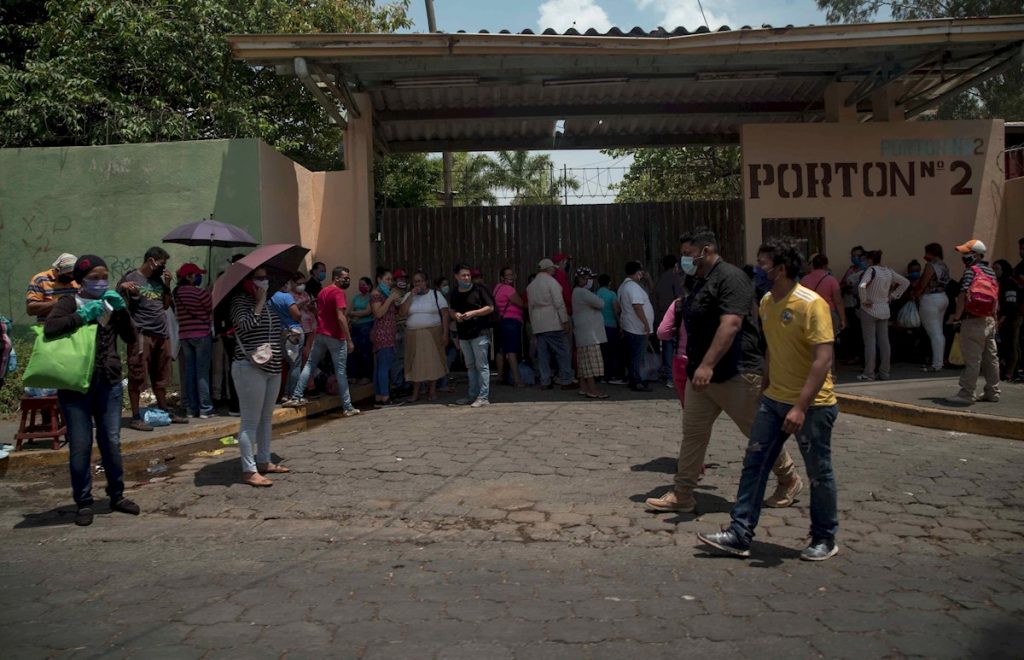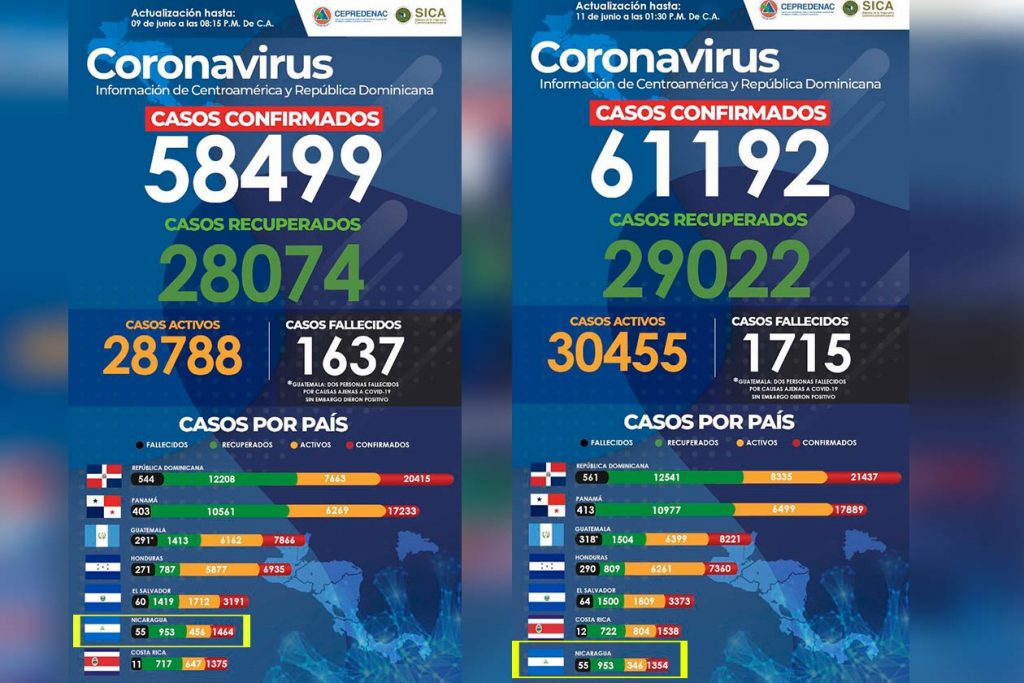The Flawed Math of Nicaragua’s Health Ministry on Covid-19

Four months after the pandemic, there are three figures on the number of infected and deceased in the country, and MINSA contradicts its own data.
By Keyling T. Romero (Confidencial)
HAVANA TIMES – In Nicaragua there are three figures on the number of Covid-19 infections and deaths. The first is that of the Ministry of Health (MINSA), which despite being the official count is the most questioned and least credible. The second is the accumulated amount recorded by the media from the same MINSA reports, which do not add up since an “adjustment” made by the Ministry. And, the third, is the unofficial monitoring of the Citizens Covid-19 Observatory, based on complaints from the population and the monitoring of independent doctors.
The Government report registers until July 14 a total of 2,682 confirmed cases, which, however, rises to 3,147 cases, if each one of the same MINSA reports are added, according to the cumulative by the media. Meanwhile, the Independent report of the Citizens’ Observatory adds up to July 15th a total of 8,508 suspected cases of Covid-19, without including the data from the report of the Ministry of Health.
The existence of this triple count is the consequence of the lack of state transparency in the handling of the pandemic, which has been widely criticized by Nicaraguan doctors and specialists, international human rights organizations, governments in the region and the Pan-American Health Organization (PAHO).
Four months after the confirmation of the first case of Covid-19 in Nicaragua, the Health Authorities continue to hide basic information about infections such as gender, age, place of origin or type of transmission, without which it is impossible to understand the behavior of coronavirus. Nicaragua is the only country in the region that did not established any type of safeguard or quarantine to prevent the spread of coronavirus.
The contradictory figures of MINSA
In addition, there is mistrust in the official registry due to the government’s reluctance to carry out massive Covid-19 tests, and due to the reports of deaths of patients with symptoms of the disease that were typified by other causes such as “atypical pneumonia” or “comorbidities”, but were buried in sealed coffins in the “express” fashion, following the MINSA protocol to bury patients with Covid-19.
The State “disguises” the data
In May, MINSA changed the frequency with which it reported on the progress of Covid-19, going from daily to weekly reports. In addition, it stopped saying the exact number of infections to date and limited itself to detailing the cases that had been treated the previous week, omitting since late April data on gender and age, which it did provide in the first daily reports.
This caused the media to start adding up the data reported weekly. For example, if 25 cases were reported as of May 12, in the next report–published on the 19th of that month–254 cases that were treated that week, according to the MINSA, were added, resulting in a total of 279 infections up to that time.
This figure was retaken by the World Health Organization (WHO) and by the Coordination Center for Natural Disaster Prevention in Central America and the Dominican Republic (CEPREDENAC SICA), which monitors the cases reported in the region, based on data of each government.
However, between May 26 and June 9, the data taken by these organizations changed, as they began to record as total infections, the number of Nicaraguans who were in “responsible and careful monitoring,” according to Ministry.
What is “responsible and careful monitoring”?
The term is another ingredient in the confusion created by the Nicaraguan Health authorities. Until May, the term “responsible and careful monitoring” referred to suspected cases of Covid-19, which were under observation, even though they were not confirmed contagion.
However, from the end of May to the beginning of June, the term began to be used to unify the total number of cases, including those confirmed, active and recovered, as has been disseminated by the media linked to the Government and the platforms of official propaganda.
In each MINSA report, the expression “in responsible and careful monitoring” is used four times. It is in the first paragraph, to detail the number of cases attended in the week and it is specified that they are “Nicaraguans clinically confirmed or suspected of Covid-19.”
Afterwards, it is used to explain the number of people who recovered in the last seven days, and then the total number of patients who were “monitored” up to that date is read, which is now the data that the Government is providing to international organizations.
An analysis of Confidencial, on the evolution of this data from each daily or weekly MINSA report, confirms the attempt to report fewer cases since June, when the number of people in “responsible and careful monitoring” became the accumulated number of cases, despite the fact that MINSA had avoided giving totals in each of its reports, especially when, between March and April, it reported one or no cases per day.
With the change in the use of the term, now MINSA contradicts itself even among its own reports, as shown, for example, by the report of May 12, in which it reported 25 confirmed cases, but explained that until that date the number of people in “responsible and careful monitoring” amounted to 216, without providing details on these, and subtracting them from each report by passing them to “home (or loving) care” over the days.
Organizations adjusted figures to the official report

The first organization to change the data, following the new official count, was the World Health Organization (WHO), as evidenced in the progress report 130, in which they recognize 885 cases. CEPREDENAC joined this change on June 10. On that day, the Center even retracted from the figure it had published the day before, in which it added 1,464 cases and lowered the number to 1,354, which was the figure that the government reported as cases in “responsible and careful monitoring.”
For their part, the government media have taken up the sum of cases under monitoring as if it were the number of infections.
“(The Minister of Health) emphasizes that since the first reported case of coronavirus that occurred in early March, until today, Tuesday, July 14, 2,682 patients with the virus have been treated,” in contrast to the 3,147 infections recorded by the independent media.
In official media, the “confusion” is not recent. Before, in tune with the MINSA, they had already begun to subtract the deceased and recovered patients from the total number of infections, reporting only the active cases. However, on that occasion it was not possible to confuse international organizations.
Doctors demand transparency of data and language
Understanding the behavior of the pandemic in Nicaragua is impossible, because there is no access to sufficient data and because the Ministry of Health have taken upon itself to use an unclear terminology with the limited information available.
Furthermore, MINSA has been questioned for the use of phrases such as “delicate, but stable” patients, “delicate and cared for,” “contact with foreigners,” patient in “responsible and careful monitoring” and “home (or loving) care.”
In May, more than 200 doctors first, and more than 700 later, demanded that international epidemiological standards be applied and clear, technical language be used.
PAHO has also noted a lack of transparency with the data from Nicaragua and has expressed concern that extreme measures are not being taken to stop the pandemic and that it is the only country that does not provide information on tests to identify SARS-CoV-2.
“We need a PAHO audit on the handling of the pandemic in Nicaragua. An audit that examines the protocols and technical-scientific action guides—if they exist—and assess the quality of the processes, compliance and results,” demanded molecular biologist Jorge Huete, after commenting that it is difficult to understand the “unique and original jargon of MINSA,” with “delicate and cared for” and “delicate, but stable.”





